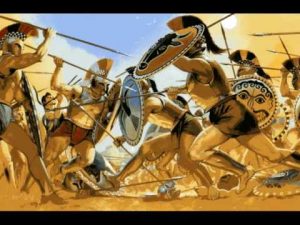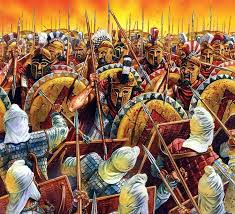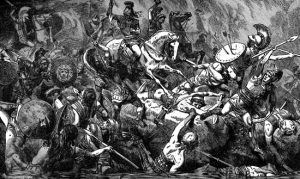Wars were very common in ancient Greece. The city-states – Athens, Sparta, Corinth, and Thebes – were always fighting each other over their borders. Often they would get together in leagues, a lot of city-states together, to fight as allies. In Athens, Ancient Greece military and Wars service were determined by a citizen’s social and economic position. In the early sixth century B.C., the arson Solon instituted four classes defined by income and gave each class a proportionate measure of political responsibility.

The second wealthiest class, the hippies (“horsemen”), earned enough from their land to maintain a horse and so fought as cavalry; the third wealthiest group, the agitate, were able to afford the equipment of a hop-lite; the wealthiest class, the Pentakosiomedimnoi (“five-hundred-bushel men”), supplied the leaders for the armed forces; and the poorest class, the thees, were hired laborers who served as oarsmen in the Athenian fleet, or as archers and light-armed men on land.
Why were wars so common?
Ancient Greece had a very rough topography and mountainous terrain. This type of geography made communication between the different areas very difficult. This led to the rise of small city-states with their different political structures, culture and practices. Ancient Greece consisted of close to 1000 islands and almost a similar number of city-states and the presence of so many states in a small area gave rise to conflicts.
Similarly, this mountainous terrain made agriculture very difficult and only 20 per cent of the land was fertile. This led to a scarcity of resources and pressure on the states for resources which made wars almost inevitable. The states went to war for capturing cultivable land and other resources. The main reason for the prosperity of states like Athens was their ability to bully smaller states into submission and force them to give tribute.
Nature of Ancient Greek War
Wars in ancient Greece were generally fought in the summer. At first, citizens were called as volunteers to fight whenever their city-state was threatened. By the end of the fifth century, standing armies and required military service was the norm. Before going into battle, the armies sacrificed to Ares or Athena, the god, and goddess of war

With the onset of the Dark ages and the downfall of civilisation, armoured aristocrats gave way to melee battles by lightly clad infantry where missile weapons were used initially to weaken the enemy before engaging in hand-to-hand combat.
The rise of the archaic age and the classical period gave way to the rise of heavily armoured soldiers known as the Hoplites. They fought in tight formations where brotherhood and resilience were more appreciated than individual skill. These hoplites were mainly farmers and they preferred a decisive front-to-front battle with very little space for tactics. It was a very seasonal type of war which was fought in the uncultivatable season as they were not permanent armies like modern armies except in Sparta.
These hoplites were perfected in the times of Philip who introduced innovations and other units like missile throwers and cavalry which made them very efficient even outside the Greek lands.
Inventions of Ancient Greece Military and Wars
Ancient Greeks invented the use of technology in warfare. It is the base of the military superiority of the civilization of the West. The first such invention was the Phalanx which was used against the Persians. The Athenians produced very fast triremes.
Invention of Catapults
The Greeks in Sicily developed the first advanced catapults. Catapults were mainly invented by Ancient Greeks. There is some evidence that probably Persians and others also used even earlier Catapults although not much is known today. Greek engineers are believed to be the designers of the most effective war engines used by the Romans.

Alexandrian innovations
In the period of Alexander, the Great colossal siege engines were produced. Alexander introduced an army that could move very fast (even today very important) a fact which requires an organization and planning. The Greek Ptolemaic kings of Egypt produced very large ships.
The Phalanx and the Trireme ship were important for Athens to be victorious against a much larger Persian Army, but the Ancient Greece Military and Wars technology was developed less by Athenians but by other Greek groups. The Phalanx is considered a Spartan invention. Sparta transformed into a militaristic society (especially due to the Messenian wars experience) in order to be able to control the much larger number of Helots and Perioikoi working for the Spartans more or less as slaves.

A hoplite phalanx was a very strong Ancient Greece Military and Wars formation – but it only worked if all the soldiers were well trained and if they were all brave enough to hold the line. If anyone started to run away, the whole line would fall apart, and it wouldn’t work.
Ancient Greece Soldiers
Athenian soldiers were required to serve two years in the military, one in the garrison and one in a border fort. After the first year, they were given a sword and a shield with the state’s emblem on it. Although they served only two years, they could be called at any moment up to age sixty. The army consisted of horsemen and hoplites, foot soldiers.
They were armed with swords, shields, and extremely long lances. Most wars between city-states were due to problems concerning harvests or livestock, sometimes only lasting a day or so. There was a truce called every four years in Greece in order for representatives of various city-states to compete in the Olympic Games.
Wars of ancient Greece
The Persian Wars
The Greeks had been into seasonal warfare with each other for several years but it was in the 5th century BC when they faced the serious challenge of foreign invasions by the Persians. Firstly under Darius, the Persians invaded the Greek lands but the Greeks due to their superiority in water and also due to lack of knowledge about Greek geography their invasion failed and they were routed in the battle of Marathon.
But again under Xerxes, the Persians invaded with a huge army which no state could match. They marched into the Greek lands and even burned Athens, which had already been deserted. But the tide of the battle changed with the battle of Thermopylae when about 300 spartan soldiers stopped thousand of Persian soldiers for three days which was a turning point and also a motivation for the Greeks. The states managed to combine in a Hellenic league to fight this huge Persian army and they were defeated in the battle of Salamis.
Peloponnesian War
The Peloponnesian war was another significant war which involved almost all of the Greek city-states. It was fought between the Delian league under Athens and the Peloponnesian league under Sparta.
The fight was between two contrasting powers where Athens was a prosperous democratic state with the most powerful army while Sparta was a more conservative strength living on frugal means and supposedly had the best hoplite army.
The war was brutal and stretched to about 30 years where Athens with their naval strength avoided fighting face to face on land while pouring in soldiers in strategic positions. But a deadly plague and then a suicidal Sicilian invasion led to the turning of the war in favour of the Peloponnese.
Sparta built a formidable navy as well in the process with the help of Persians and managed to win the war leading to the downfall of Athens.
The wars of Alexander
Alexander, building upon the innovations of his father, began on an adventurous journey across the world capturing lands and building one of the largest empires the world has ever seen.
After conquering the central Asian lands he turned his attention toward the Indian subcontinent where he is said to have faced his most difficult enemy in Porus in the battle of Hydaspes. He wanted to move further into the Indian lands but his army mutinied and had to turn back.
He fought several wars before dying at the age of 33 and his empire stretched from the Greek lands to Africa up to the Indian subcontinent.